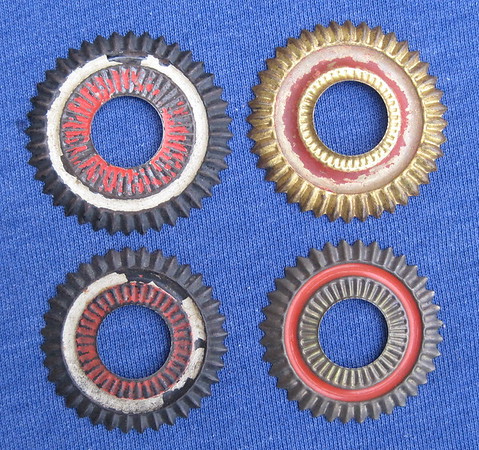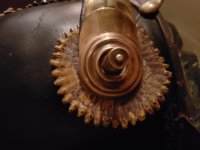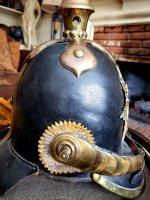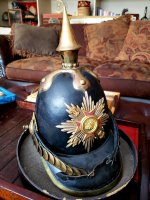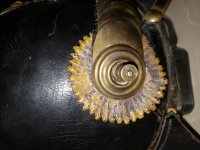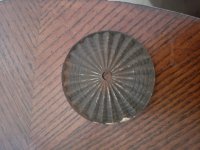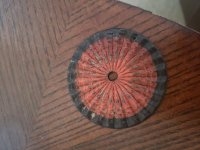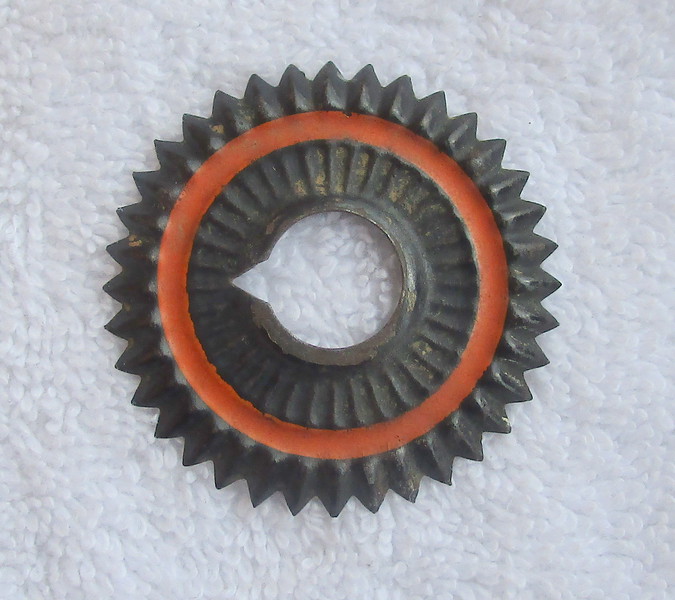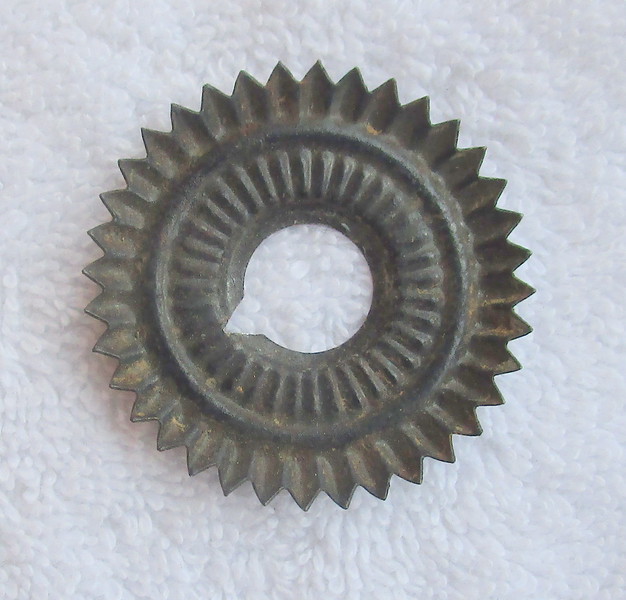You are using an out of date browser. It may not display this or other websites correctly.
You should upgrade or use an alternative browser.
You should upgrade or use an alternative browser.
Officer and OR's Kokarden
- Thread starter b.loree
- Start date
I am bit confused Andy....the Reichs cockade (red,white,black) is the larger one at 55mm and the Prussian (black,white) is smaller at 50mm, I think you mixed these up. Anyway, it's obvious what you meant. Cavalry wore larger kokarden so your Reichs kokarde could be cavalry. I have 2 kokarden from my Baden Dragoner (private purchase) helmet that match the size of your Reichs kokarde.
joerookery
Well-known member
Andy,
Good question. Very good question. In my mind still very grey. there are some anomalies I just cannot seem to square. Size of these seems to be all over the place. One possibility indeed is manufacturer. But I do not know.
I visited your country however and believe we have much to learn as a nation from the things you have accomplished in yours.
Good question. Very good question. In my mind still very grey. there are some anomalies I just cannot seem to square. Size of these seems to be all over the place. One possibility indeed is manufacturer. But I do not know.
I visited your country however and believe we have much to learn as a nation from the things you have accomplished in yours.
In regard to my Baden Dragoner, it is private purchase with officer style chin scales. However, the kokarden which came with it and I feel are original to the helmet are OR's M91 (large hole). This makes no sense according to what should be there but there it is.
SkipperJohn
Well-known member
I have been asked to add a few photos of some older Kokarden to this post, so here they are:
This is an example of the very first Prussian Kokarde to adorn a helmet:

This Kokarde is on a Model 1809 Kurassier helmet. Earlier Kokarden were worn on a tricorn hat. The 75mm Kokarde is made of silk and is colored in standard Prussian colors, black-white-black. Silk is a highly resilient material which can last hundreds of years unless it had been weighted. In the 1840’s manufacturers began weighting silk with sugars and metallic salts to increase profits. It was perfectly legal but the silk material was weakened by it. Weighted silks can dry out, shred, and they do not hold dyes well. Weighted silks also have a tendency to glow under black light, raw silks do not. This Kokarde does not glow under black light.
Here is a pressed wool Kokarde:



This Kokarde is on a Model 1857/60 Fusilier Helmet. The Kokarde appears, at first, to be made of leather, but a closer inspection reveals that it is made of pressed and painted wool. Pressed and painted wool (like heavy felt) was used on models prior to 1857, so this is likely a "left-over" part from an earlier model. It was probably 75mm at one time, but it has shrunk over time.
This is an example of a 75mm stamped metal Kokarde:

This is on a Model 1860 Kugelhelm for the Fuβartillerie. The 75mm stamped metal Kokarde was implemented in 1857 to replace the wool Kokarde.
Here is an unusual 68mm stamped metal Kokarde:

This is on a Model 1853/60 Kürassier Metalhelm. The Kokarde is stamped and seems appropriate in every way --- except size. Prior to 1860 the Kokarde size was 73mm. After 1860 the Kokarde was changed to 63mm. The Kokarde on this helmet measures 68mm --- exactly half way between the two specifications.
This is a 56mm Bremen Kokarde on a Model 1860:

The Kokarde measures 56mm. It is flat instead of convex, which is typical for Bremen, and it has the Hanseatic Maltese cross. The cross is stamped into the Kokarde and not just painted on. The Maltese cross was used by Bremen until 1897 when the Kokarde switched to a white serrated disc with a red ring. The 56mm stamped Kokarde was implemented in 1860 because of the reduced height of the helmet.
John
This is an example of the very first Prussian Kokarde to adorn a helmet:

This Kokarde is on a Model 1809 Kurassier helmet. Earlier Kokarden were worn on a tricorn hat. The 75mm Kokarde is made of silk and is colored in standard Prussian colors, black-white-black. Silk is a highly resilient material which can last hundreds of years unless it had been weighted. In the 1840’s manufacturers began weighting silk with sugars and metallic salts to increase profits. It was perfectly legal but the silk material was weakened by it. Weighted silks can dry out, shred, and they do not hold dyes well. Weighted silks also have a tendency to glow under black light, raw silks do not. This Kokarde does not glow under black light.
Here is a pressed wool Kokarde:



This Kokarde is on a Model 1857/60 Fusilier Helmet. The Kokarde appears, at first, to be made of leather, but a closer inspection reveals that it is made of pressed and painted wool. Pressed and painted wool (like heavy felt) was used on models prior to 1857, so this is likely a "left-over" part from an earlier model. It was probably 75mm at one time, but it has shrunk over time.
This is an example of a 75mm stamped metal Kokarde:

This is on a Model 1860 Kugelhelm for the Fuβartillerie. The 75mm stamped metal Kokarde was implemented in 1857 to replace the wool Kokarde.
Here is an unusual 68mm stamped metal Kokarde:

This is on a Model 1853/60 Kürassier Metalhelm. The Kokarde is stamped and seems appropriate in every way --- except size. Prior to 1860 the Kokarde size was 73mm. After 1860 the Kokarde was changed to 63mm. The Kokarde on this helmet measures 68mm --- exactly half way between the two specifications.
This is a 56mm Bremen Kokarde on a Model 1860:

The Kokarde measures 56mm. It is flat instead of convex, which is typical for Bremen, and it has the Hanseatic Maltese cross. The cross is stamped into the Kokarde and not just painted on. The Maltese cross was used by Bremen until 1897 when the Kokarde switched to a white serrated disc with a red ring. The 56mm stamped Kokarde was implemented in 1860 because of the reduced height of the helmet.
John
Great stuff John, Will try to add to it as I can.
James
James
Matched pair of Baden NCO kokarden which came from the same helmet.
https://photos.smugmug.com/Kokarden/i-Hw7RCb7/0/5105a969/M/IMG_1193-M.jpg
Unfortunately, the shell was trashed but it did have an officer wappen on it. The wappen was damaged as well so I did not buy that.
https://photos.smugmug.com/Kokarden/i-mT2QT4z/0/97fbcd36/M/IMG_1196-M.jpg
Note the brass prongs on the State kokarde while the Reichs has the typical white metal ones.
https://photos.smugmug.com/Kokarden/i-Hw7RCb7/0/5105a969/M/IMG_1193-M.jpg
Unfortunately, the shell was trashed but it did have an officer wappen on it. The wappen was damaged as well so I did not buy that.
https://photos.smugmug.com/Kokarden/i-mT2QT4z/0/97fbcd36/M/IMG_1196-M.jpg
Note the brass prongs on the State kokarde while the Reichs has the typical white metal ones.
I'm going to state the obvious here, I believe that the V notch on these kokarden was to stop the kokarde from falling off the M91 post once the strap fitting was removed. Everytime, I remove a strap form one of my helmets with non V kokarden, they fall off the posts. I do find it interesting though, that we find the V notch on Prussian kit helmets, Wurttemberg (rare) and Saxon but on none of the other German states kokarden, I would gladly invite any member who can provide other V notch examples from their collections to step forward here. Again the M91 post design was a very good one for locking the strap/scales to the post and provided quicker removal than the old bolt on scales. It also removed one other part...the white metal ring/washer which went between the bolt and kokade. So I think obviously that the M91 system simplified everything and thus saved money but at the cost of lost kokarden. My thanks to aicusv for his comments, I am trying to rejuvenate this thread as for the most part, on OR's helmets or other private purchase M91 helmets, the kokarden are missing. I also worked on one private purchase helmet where the kokarden were put on the shell then the posts were applied thereby locking them against the helmet shell. Obviously, this tells us that lost kokarden could be a problem but at the same time, hmm..... shelling out cash for this custom helme and it does have locked in kokarden ok I'm good for that! We have to continually realise that all of these private purchased helmets were "pitched" by salesmen just as today. I would also like to remind members, that this military equipment industry in Germany must have been/was huge! Certainly the Kaiser was on board with his granting bandeau to the Kings German Legions, the Reichs kokarde and his expansion of Regts during the 1890's (cost?). I mean..obviously this fed German industry! Anyway, food for thought as we live through these times.
Sandmann
Well-known member
Think this post with information on the Saxon clothing regulations and the "V" shaped notch should be linked to this post:
The history of the pickelhaube in the Royal Saxon army from 1867 -1918
Dear friends, I‘m glad to present you my latest Blog entry on my website Historien-Kabinett.de in English and German. This time I have focussed myself to the development of the pickelhauben in the Royal Saxon Army, and tried to track the changes in helmet dimensions using original documents as...
www.pickelhaubes.com
Nacuaa
Active member
The 1840 shako that preceded this helmet just turned up on Ebay. It looks as though the shako plate was added directly to the helmet when it was adopted.Here is a leather kokarde on a 1. Badisches Leib-Grenadier-Regiment Nr. 109 early pickelhaube.
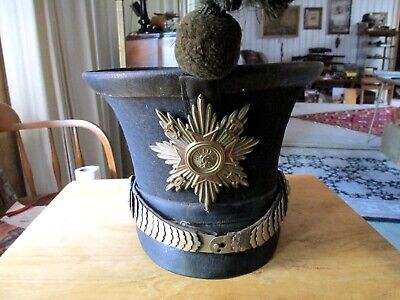
RARE ORIGINAL 1810-1820 French Napoleon Helmet Shako German? very good+ | eBay
Find many great new & used options and get the best deals for RARE ORIGINAL 1810-1820 French Napoleon Helmet Shako German? very good+ at the best online prices at eBay! Free shipping for many products!
www.ebay.com

